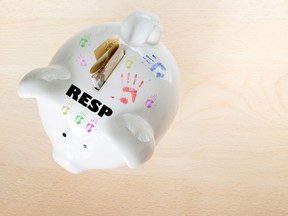In the end, how you use the money left over in the RESP is up to you

Article content
By Julie Cazzin with Janet Gray
Advertisement 2
Article content
Q: What happens to the remaining balance in a registered education savings plan (RESP) after the kids have finished their education? There’s about $40,000 left in the account (both my kids chose to stay home for university) and I’m wondering what the best use for these funds would be? Part of me would like to do something for the kids that would help them learn about investing. But is it more tax efficient to keep this money for myself? — Alana
Article content
FP Answers: Alana, it’s key to remember an RESP has three components:
Your contributions: You contributed after-tax dollars to the RESP, up to the annual limit of $2,500 annually per child (or $5,000 to catch up two years at a time). This is your capital (or principal). Lifetime contributions are $50,000 per child. When you withdraw the principal from the RESP, it is tax free.
Advertisement 3
Article content
Grants: The federal Canada Education Savings Grant (CESG) provided 20 per cent on your contributions up to $500 per year ($1,000 in catch-up years) with a lifetime limit of $7,200 per child. Depending on your income level over the years, you may have also received the Canada Learning Bond (CLB) and other provincial grants.
The earnings of the combined contribution and grants: These earnings will depend on how you invested the money. They include interest, dividend or capital gains income you may have earned on your principal or the government grants.
Your contributions belong to you and you can assign this money to your child. The government grants and earnings from the grants are taxed in the name of your child when they are registered and attending an eligible post-secondary institution at the time of withdrawal.
Advertisement 4
Article content
We also need to consider the three types of RESPs: individual, family and group. Each has its own specific set of rules so be sure to check with your RESP provider for details on your particular type.
Alana, if neither of your children is now qualified to attend a post-secondary institution, you have several options when deciding what to do with the RESP money.
Keep it in place: An RESP can remain open up to 35 years and can be used at a later date, perhaps for postgraduate education or skills training at some point when your child is older and wants to further his studies.
Close the RESP: The contribution/principal portion is returned to you in full, but the earnings (known as the accumulated income payment (AIP)) in the RESP are paid out to you and taxed at your marginal tax rate. You will also have to pay a penalty of 20 per cent on top of that. Any unused government grant money (if there is any) is forfeited and repaid to the government.
Advertisement 5
Article content
Transfer earnings to your registered retirement savings plan (RRSP): Up to $50,000 can be transferred to your RRSP if you or your spouse have available contribution room. You also have to meet a few conditions to consider this option: the RESP has to have been in place for over 10 years, the beneficiaries are more than 21 years old, you are a Canadian resident and, if the plan rules allow, the remaining grant, if any, is forfeited and repaid to the government.
Changing beneficiaries: Some plans (such as the family RESP) may allow you to change or add another beneficiary who is related to you. Government grants can only be used for new beneficiaries who are siblings of the original grant recipient.
In the end, how you use the money left over in the RESP is up to you. If you have high-interest debt, it would be helpful to reduce it. If you are a high-income earner, an RRSP contribution makes good tax sense. Then consider using any tax refund to add to your tax-free savings account (TFSA).
Advertisement 6
Article content
-

FP Answers: I had a heart attack 5 years ago and recently retired. What are some tips for a good drawdown strategy?
-

FP Answers: What is the benefit of a graduated rate estate when doing estate planning?
-

FP Answers: What are the best investment options for cash in my portfolio now that bond returns are lagging
-

FP Answers: How should I invest the $260,000 my father left me in his will?
Or you may choose to gift the money to your children. If you choose this option, ask yourself if your kids are financially savvy. It can be as simple as discussing suitable goals and how best to achieve them.
Finally, check the investments held in the RESP. If you’re planning to make a withdrawal soon, ensure the investments are in a secure and stable investment so any short-term market volatility will help minimize any decrease in value. The financial institution where you hold your RESP will be responsible for determining what portion of your withdrawal is considered principal, grants or income.
Advertisement 7
Article content
You may want to have a tax accountant or a financial adviser or financial planner help you decide how much can be withdrawn tax free, what amount has to be repaid to the government, and what earnings money is taxable to you or transferable to an RRSP. These decisions will help you minimize the tax bite.
Janet Gray is a fee-for-service certified financial planner with Money Coaches Canada in Ottawa.
_____________________________________________________________
If you like this story, sign up for the FP Investor Newsletter.
_____________________________________________________________
